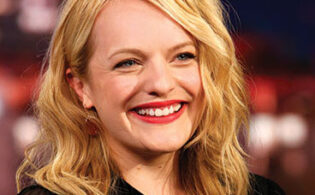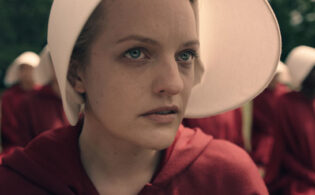PREMIUM: The Handmaid’s Tale showrunner Bruce Miller talks to World Screen about working with the writers to stay faithful to Margaret Atwood’s novel but at the same time move the story forward.
WS: How did you become involved in the project and how did you collaborate with Margaret Atwood on the first season?
MILLER: I had read the book when I was in college and it had always been a favorite of mine. I had heard that they were making it into a TV show years ago, so I had been tracking it, just as a fan of the book, waiting for it to come out—but it didn’t. As my career moved along I [continued to check] and at one point the package that had been put together of writer and studio had moved. They were looking for a showrunner and a writer, but they were looking for a woman and I’m not one. I waited very patiently and they finally were kind enough to allow me in to talk about what I would do with the show. It moved well from there. It wasn’t until after I had written the first episode that I sent something to Margaret. She read the first episode and I was very nervous. I was a huge fan of hers and I was trying to capture the book, I wasn’t trying to move away from it. But she was lovely, encouraging, enthusiastic and funny.
We spoke a lot to get to know each other. I am in as close touch as her schedule will allow. I very much feel I’m playing in her sandbox, so letting her know what I’m thinking, and her letting me know what she’s thinking of particular parts of the show, are essential to doing the show.
WS: How have you worked with the writers in season two to stay faithful to the novel but at the same time move the story forward? And has the collaboration with Margaret Atwood continued?
MILLER: The collaboration certainly has continued. Margaret reads every outline, every script. She watches every episode. She tells us what she thinks. Most of the time she is more encouraging and enthusiastic for us to divert from the original material than we are because she is in a unique position of having had her work adapted, especially this work. It’s been an opera, a ballet, a play and a movie. I think she is much more comfortable with us changing things than we are.
All the writers are very familiar with the book and we try to hew close to the tone of the Atwood world, where it’s so violent to the point of absurdity. We’re still very much following that map. In the first season, we invented events and moved things around from the book and that got our feet wet for staking out some original territory. A TV show and a book are different things, so you have to make changes to bring it to life on TV. It’s the genuine affection that writers have for the book that keeps us on track. No one is interested in moving away from it; we would love to keep circling back and keep landing in the same world that Margaret created.
WS: How did you decide on the tone and the look for the series? Some of the shots and scenes are so beautiful and at the same time so brutal. How did you achieve that?
MILLER: That’s exactly what I was hoping to achieve. When I started, I was looking around at movies and TV shows to see if there was something that I wanted it to look like. The first operating principle was that it had to feel like a real world because if it doesn’t, it’s not scary. [Second], Gilead wants everything to be beautiful on purpose; they are trying to make everything look perfect. I wanted that esthetic because it was such a part of the story and the environment—it looks beautiful, but it’s awful. It wasn’t just all these beautiful houses and streets and wardrobe and how everything looks so perfect, it was also the hangings. So I was looking around for a style that fit that was very grounded but could also be very beautiful and did that on a very simple level. It’s really Reed Morano, who directed the first three episodes, and Colin Watkinson, our DP [director of photography], who created that look. And we are still creating it. In every episode, every scene, we’re asking, What is the esthetic message? Is this a beautiful place? We think about the visuals a lot. It’s all in service of making it feel scarier.
WS: What is the atmosphere in the writers’ room considering the extremely dark nature of the stories? Do you bring that darkness home or are you able to disconnect?
MILLER: The environment in our writers’ room is wonderful, lovely, respectful and congenial, but also very funny. I know it seems strange, but because we are dealing with such dark subjects, you get to know people very well because the stories come from people’s own lives and about how they feel about things. There is definitely the feeling that we are using our imaginations; we’re not putting ourselves in these situations on a moment-by-moment basis because that would be too horrible. We are very attached to our characters and even more attached to our actors, especially when you have Elisabeth Moss, Yvonne Strahovski or Joseph Fiennes, all these wonderful actors, and you believe they are going through all this trauma. Even though they are breezy about it and are doing their work and are funny, it’s still tough to watch our friend Elisabeth Moss go through this stuff on screen. So you feel for the actors who have to bring all that stuff even though they don’t have an issue with it.
In terms of bringing it home, I don’t feel like I come home from work with all of this truly misogynistic, nightmarish, violent horror and bring it into my life. After talking about it and thinking about it all day long, I’m trying very hard not to get desensitized by it. You don’t want to bring it home. You don’t want to keep thinking about it. You want to make to make sure that it stays terrible.
WS: Has the current political climate influenced the storytelling?
MILLER: You can’t avoid letting the things happening in the world influence you when you are writing. You wouldn’t want to. It would be a fool’s errand to say I’m not going to have my head in the present when I’m writing a political story and a story about misogyny and violence and all of these things we are going through now. The fact that these political discussions are becoming so personal is helpful for us because people are much more outspoken about how they feel and what they are afraid of. Even if what they feel or what they are afraid of is terrible, they are very outspoken about it. So in some ways, people exposing their darker side helps me understand how they think. When people feel comfortable verbalizing things, it helps me understand points of view that I don’t have and that I certainly wouldn’t feel comfortable verbalizing. In general, writers, actors and directors are a news-focused bunch, engaged in the world, so there is a lot of conversation about that. I never try to draw specific parallels or try to take something that is happening and put it in the show. It’s just not the way the show works. We follow the story and it does lead to the same place [as events in the news] sometimes.
WS: Do you have in mind how many more seasons you can do and how much more story there is to tell?
MILLER: In some ways, it’s a testament to Margaret that there is an infinite amount of stories to tell. I would watch 45 seasons about the fall of Gilead and the Nuremberg trials of Serena and Fred, and the academic study and archaeology of Gilead, you could go on forever, That’s what Margaret’s worlds have in them, infinity. But my feeling about the show is I would like to make something that is beautiful and meaningful and neat—a companion to go on your shelf next to the book. As for how many years this is supposed to go, I don’t think about it that way. I think of story chunks. I certainly don’t want to wear out our welcome and don’t want the quality of the show to suffer. So as long as we can be doing excellent work and expanding the world of the novel, I’m very excited to keep doing that. I would like at some point, on our own terms, to wrap things up cleanly and neatly, out of respect for the source material and our audience. One of the things I like about the show is that we are able to have moments that are incredibly satisfying. You build up to them for so long that when they finally happen it really is a [high] level of satisfaction at the end. That is what you’re shooting for.
WS: What can you tell us about season three? Is Aunt Lydia dead?
MILLER: Aunt Lydia is not dead. In fact, when I sent the script to Ann Dowd [who plays Aunt Lydia] the subject line of the script was Aunt Lydia is not dead! She certainly is injured and has to reassess her relationship with these girls who she thought loved her so much and respected her, how could they possibly stab her in the back like that? Bradley Whitford will be back to be central to the story. We’ll see in flashback June’s mom, hopefully, and we’re going to continue to follow the story both in Toronto and Gilead. We’re continuing the story of survival, the story of fighting back, which is much more of what season three is about, and the story of motherhood and family and what it means to be a mother, that’s really what the whole show is about. The whole world of Gilead is about how complicated and elemental the terror that a society would have if its birthrate fell 80 percent in a year. It’s basic human terror that you get feeling like the last generation of a species, which drives people to do incredibly interesting things. That drive has kept us moving forward from the very beginning and will continue to drive us.



